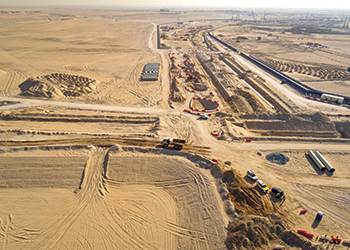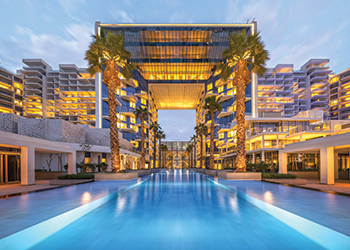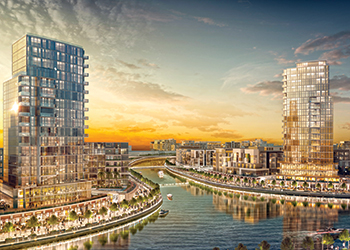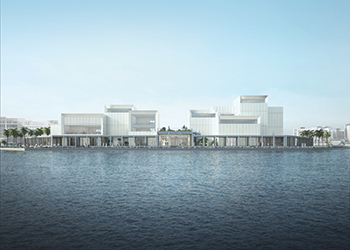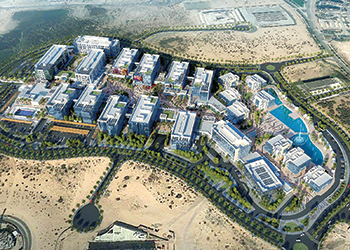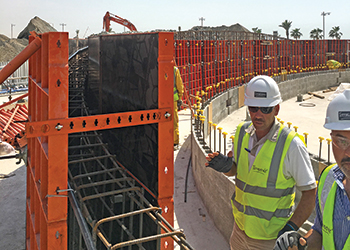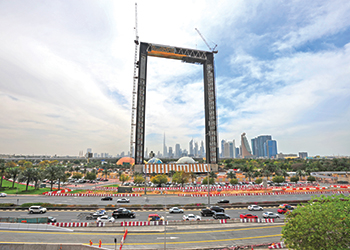
 Dubai Frame in Za’abeel Park ... measuring 150 m high and 93 m wide, is slated for completion by the year-end.
Dubai Frame in Za’abeel Park ... measuring 150 m high and 93 m wide, is slated for completion by the year-end.
The World Expo 2020 continues to fuel construction activity as Dubai powers ahead with its vision to be a world-leading business and lifestyle destination.
In February this year, Dubai amazed the world by revealing it will go boldly forward and build a small city on Mars by 2117. And while most of us may not be around to see this happen, it is indeed a compelling example of the government’s unfettered vision for Dubai to be a city that shapes and defines the way to live in the 21st century and beyond.
Closer to the ground, Dubai’s ambitions and dreams continue to delight and inspire: come July and egg-shaped autonomous drones will ferry passengers across the city, while a Hyperloop system that will cut the travelling time from Dubai to Abu Dhabi to just 12 minutes could also take flight in the not-too-distant future.
Also recently announced is another spectacular development called the Dubai Harbour – a 20-million-sq-ft megaproject which, among its myriad attractions, will boast the region’s largest marina.
The trendsetting emirate is also building the world’s first 3D-printed laboratory building as part of the Research and Development (R&D) centre at the Mohammed bin Rashid Al Maktoum Solar Park, which itself said to be the largest single-site project of its kind in the world and represents Dubai’s goals in the renewable energy sector.
This follows the construction of the world’s first 3D-printed building at the Emirates Towers premises.
For now, the catalyst for Dubai’s ambitions is the World Expo 2020, which will see some 25 million visitors converge on the emirate over six months from October 2020. The world-class event is attracting significant investment into the emirate, driving momentum into commercial building and transport infrastructure and spurring real estate development.
The expo site – work on which is in progress – will spread across a total of 4.38 sq km in Dubai South (the rebranded Dubai World Central), adjacent to Al Maktoum International Airport and is reported to be the largest ever created for a World Expo. After hosting the event, plans are also being drawn up to allow 80 per cent of the site will be reused or repurposed in the legacy phase (see Themework).
Apart from the venue itself, the event is spawning a real estate boom with massive projects announced in and around Dubai South. Among such major projects announced this year is Emaar South.
Other fulcrums of growth are Mohammed bin Rashid City (MBR City) and the zone around the recently-inaugurated Dubai Water Canal, a 3.2-km-long tourist landmark built at a cost of $735 million in the heart of the city.
Transport
The RTA has been playing a pivotal role in spearheading vital infrastructure in the emirate, with the latest futuristic initiatives on the anvil being the self-flying drones or autonomous aerial vehicle (AAV) expected to be launched in July.
The authority has also signed up Hyperloop One of the US to study the feasibility of installing its new form of high-speed routes that will reduce travel time between Abu Dhabi and Dubai to 12 minutes from the present two-hour drive.
To facilitate visitors to the Expo 2020 site, the RTA last year awarded a Dh10.6-billion ($2.8 billion) contract for the Route 2020 metro expansion. The 15-km extension is expected to be launched in the first quarter of 2020.
Early this year, the RTA also gave the go-ahead for the second and third phases of its Light Rail Transit system extension.
Airport
The mega Expo 2020 event has necessitated the expansion of Al Maktoum International Airport at Dubai South. Part of a wider $33-billion development, the expansion of the terminal will include a larger immigration hall with 55 control counters, an extended departure area with 91 check-in desks and an extra 12 boarding gates and lounges.
Meanwhile, a huge VIP Terminal has recently been opened minutes away from Al Maktoum International. The 5,600-sq-m terminal, said to be the largest of its kind in the world, is poised to be a game changer in the business aviation sector.
Power & Water
In the power and water sector too, the emirate is demonstrating its leadership and commitment to sustainability. It is developing the largest single-site strategic solar energy project of its kind in the world – the Mohammed bin Rashid Al Maktoum Solar Park – based on the independent power producer (IPP) model. Following the opening of the 13-MW first phase in 2013, the 200-MW second phase was inaugurated last month. A Masdar-led consortium is developing the 800-MW third phase of the project which is to be completed by 2020, while the 200-MW fourth phase is at the tendering stage.
The total capacity of the solar park will reach 1,000 MW by 2020, and 5,000 MW by 2030, with total investments of Dh50 billion ($13.6 billion).
Among other developments, work is under way on the Hassyan clean coal power station – the first of its kind in the region – which is being developed on the IPP procurement model. The project, which will have a total coal-fired capacity of 2,400 MW by 2023.
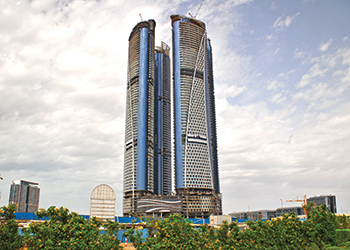 |
|
Damac Towers by Paramount Hotels & Resorts ... due for completion this year. |
Real Estate
Dubai South, an emerging 145-sq-km city launched in 2006, is poised to become the epicentre of construction activity as well as a magnet for real estate development over the next three years.
Contracts worth Dh1 billion ($272 million) were awarded in July last year for a number of developments in the city’s Residential District, adjoining the Expo 2020 Dubai site, that will have around 10,000 residential units by 2020. Work is also in progress on the Logistics District and a multi-purpose aerospace supply chain facility in the Aviation District.
Infrastructure work under way on Phase One is scheduled to be completed by the fourth quarter of 2017. This will pave the way for more than 40 developers to expedite their developments in the district.
Damac Properties stakes claim to having completed the first residential project – Damac Maison de Ville Tenora hotel apartments – in Dubai South. Work is also at an advanced stage on its Damac Maison de Ville Celestia, which will be delivered in 2018.
Damac’s other major projects in Dubai include the luxury hotel and serviced residences Damac Towers by Paramount Hotels & Resorts in Burj area, which is due for completion this year; Akoya Oxygen master development; Akoya by Damac golf community; and Aykon City development on Sheikh Zayed Road.
Among other developers planning projects in Dubai South are Emaar Properties which has recently unveiled plans for Emaar South, a dedicated golf district; and Mag 5 Property Development (MAG 5 PD), which is building the MAG 5 Boulevard project, a medium-income housing community comprising 1,172 residential units, complemented by an array of retail, dining, leisure and entertainment facilities (see Real Estate).
Meanwhile, Emaar Properties has already broken ground on its $1-billion development – The Tower in Dubai Creek Harbour – which, on completion in 2020, will become the world’s tallest tower, overtaking the iconic Burj Khalifa.
Supported by a matrix of cables, the skyscraper will anchor the redevelopment of the Dubai Creek. The Tower will sit in the middle of Dubai Creek Harbour, a 6-sq-km masterplanned development. Emaar has also unveiled high-end residences at the development.
Another massive project that is targeting a 2020 deadline is the first phase of the Dh25-billion ($6.8 billion) District One project at MBR City. District One is being developed and built by Meydan Sobha on an area of 50 million sq m. The development includes the $4-billion Sobha Hartland, which is located on the new Dubai Water Canal, the first units of which will be completed from December 2017.
Also targeting a 2020 completion are two stunning projects by Nakheel: the Dh5-billion ($1.36 billion) Deira Islands Towers & Boulevard – tenders for which has just been invited, and Palm 360, a twin-tower hotel and residential project on The Palm Jumeirah’s western crescent.
Also vying to be Dubai’s number one attraction during the Expo 2020 is the mega Meydan One development, which last month broke ground on its first phase development, the Meydan One Mall (see Architectural icon).
Other key developments include:
• One Central: A Dh8-billion ($2.1 billion) mixed-use development being managed by Dubai World Trade Centre Authority.
• Jumeirah Central: An urban city district being developed by Dubai Holding that will boast 9 million sq ft of retail space including three malls, 4.5 million sq ft of outdoor shopping space, and 7,200 hotel rooms.
• Sustainable City: This net zero energy city spread over a five-million-sq-ft area in Dubailand is the Middle East’s first operational sustainable community. Following the success of the first phase comprising 500 villas, its UAE-based developer Diamond Developers plans to start construction on the second phase, which will see the construction of an eco-resort, a country club, a green school, a science museum and the sustainability centre of excellence.
• Town Square: Centrally located in New Dubai along Al Qudra Road, this development by Nshama will comprise more than 3,000 townhouses and 18,000 apartments. Work is in progress on 1,050 townhouses and 1,100 apartments in addition to other infrastructure work. Town Square is anchored by a central square that is the size of 16 football fields.
• Jebel Ali Gardens: Nakheel has tasked six Emirati-led companies to oversee the design and construction supervision of the sprawling Dh7.5-billion ($2.04 billion) Jebel Ali Gardens community, where 42 towers will house 40,000 people in nearly 10,000 apartments.
• Heart of Europe: Kleindienst recently awarded contracts worth Dh4.8 billion ($1.3 billion) for the development of The Heart of Europe, a cluster of six islands on The World located 4 km off the coast of Dubai.
• Dubai Harbour: This new waterfront destination spread over 20 million sq ft will boast the largest marina in the Middle East and North Africa (Mena) region. The project, located between Jumeirah Beach Residence and Palm Jumeirah, will be developed by Meraas. It will include a 1,400-berth marina as well as a cruise ship port and terminal, a shopping mall, residential buildings, hotels, and an iconic 135-m-high tower featuring a luxury hotel and observation deck, called ‘Dubai Lighthouse’.
• Marasi Business Bay: Work is under way on Dubai Holding’s new $272-million waterfront destination along the creek, which is said to be the region’s first purpose-built yachting destination, featuring the UAE’s first-ever water homes.
Retail facilities
Ranked among the top 17 of the most active cities for shopping centre development, according to CBRE’s latest Global Shopping Centre Development report, Dubai currently has 361,127 sq m of retail space under construction with further projects on the anvil.
These include plans for the world’s biggest shopping mall – the Dh25-billion ($6.8 billion) Mall of the World by Dubai Holding, which was initially proposed for Sheikh Zayed Road but will now be relocated to a site on Sheikh Mohammad bin Zayed Road.
Nakheel has plans for a Dh4-billion ($1.1 billion) mega destination mall on Deira Islands. It is currently building the Dh2-billion ($544 million) Al Khail Avenue retail, dining and entertainment hub; a new 375,000-sq-ft showroom complex at Dragon City; and the Dh1.2-billion ($327 million) Nakheel coming up at the heart of Palm Jumeirah.
Other projects
• Opera House: The UAE’s first opera, housed in an iconic dhow-shaped building at the foot of the iconic Burj Khalifa, opened its doors to the public last October.
• IMG Worlds of Legends: IMG Worlds is to build IMG Worlds of Legends, which is expected to open in time for Expo 2020. The new development will take over the title of the world’s biggest indoor theme park from the operator’s first park, IMG Worlds of Adventure, which opened in 2015.
• Dubai Arena: Work has started on a huge multipurpose arena spanning over half-a-million sq ft with a seating capacity of 20,000, which will be the only all-purpose indoor air-conditioned arena of its size in the entire region, according to its developer Meraas.
• Mohammed bin Rashid Library: Work has started on this Dh1-billion ($272 million) library, which is described as the biggest cultural project of its kind in the Arab world.
• Six Flags-branded theme park: Dubai Parks and Resorts, billed as the region’s largest theme park destination, has launched work on the first Six Flags-branded theme park in the region, which will be its fourth theme park alongside motiongate Dubai, Legoland Dubai, and Bollywood Parks Dubai. Planned to open in late 2019, Six Flags Dubai is part of Phase Two of the Dh10.5-billion ($2.88 billion) development that opened its doors last October.
• Mohammed bin Rashid Stadium: This landmark stadium with a seating capacity of 60,000 will be set up at a cost of Dh3 billion ($816 million) within the Dubai Club premises in Al Aweer. On completion, it is set to become the world’s first fully air-conditioned and raised-off-the-ground stadium.





















_0001.jpg)


.jpg)
















.jpg)








.jpg)




